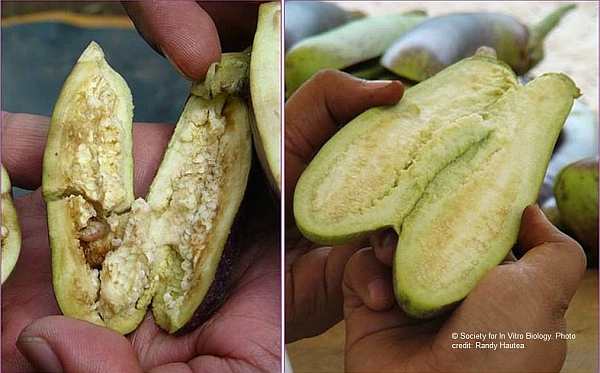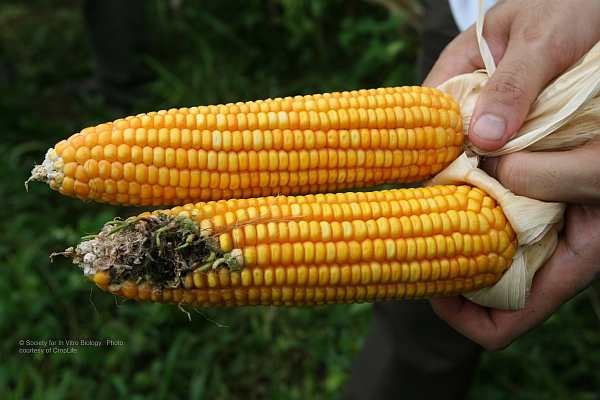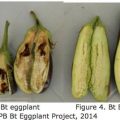The Philippines needs to put policies needed to bring to the poor genetically modified (GM) crops like the Vitamin A-rich rice to help solve worsening hunger problem globally.
Food production needs to be raised by 70 to 100 percent in the next 30 years according to the Food and Agriculture Organization (FAO).
This is as population is seen to rise to nine billion by 2050 from the present seven billion.
And GM technology can raise food production and nutrient level in crops, making it possible to meet the increasing food demand, according to Dr. Wayne Parrott of the University of Georgia-Institute of Plant Breeding, Genetics, and Genomics.
Parrott visited the Philippines last week in the aftermath of the uprooting of Golden Rice plants under field trial in Camarines Sur.
While GM crops are a positive development, the government has to make decisions that will determine whether this increase in food production will happen.
“We have the technology to meet the need of the future. What we don’t have yet is the will power, the regulatory system to allow use of the technology that we need,” Parrott said.
The Philippines is liable to the poor of the world in helping solve hunger and malnutrition problems.
The Philippines is host to the field trial of the Vitamin A-enhanced Golden Rice being conducted by the International Rice Research Institute based in Los Banos, Laguna and the state-run Philippine Rice Research Institute.
The country is also host to the field trial of the GM Bacillus thuringiensis (Bt) eggplant by the state-run Institute of Plant Breeding of the University of the Philippines Los Banos.
Rice is the most consumed food in the world. The nutrient content in rice determines whether hunger and malnutrition are reduced as it is a staple of around 50 percent of global population particularly developing countries in Asia.
Eggplant is the most consumed vegetable in Asia including developing countries as Philippines, Bangladesh, and India.
“The recent destruction (of Golden Rice plants) that took place in the Philippines attracted global attention. The global spotlight is now on the Philippines because Golden Rice gets more positive press in the world,” said Parrott.
Golden Rice efficacy
The National Institutes of Health in Maryland reported that Golden Rice contains up to 35 micrograms of betacarotene and is“effectively converted to Vitamin A in humans.”
Golden Rice is enough to eliminate symptoms of Vitamin A deficiency just by a regular intake of 50 grams per day.

Golden Rice’s bioavailability or its conversion into Vitamin A in the human body has been tested favorable on the target Vitamin A-deficient patients.
“If it’s approved, the Helen Keller Foundation for the blind will do monitoring of Golden Rice (efficacy),” Parrott said.
“There are 500,000 cases of irreversible blindness each year. It doesn’t stop there. If you’re Vitamin A deficient, you’re predisposed to other diseases. There are two million deaths from complications due to Vitamin A deficiency. And we can do something about it,” he said.
Consumers should look at GM crops as a way to help solve food shortage.
“GM technology is part of the solution, not part of the problem. We’re better off if we consider it as a way to solve the problem to be solved,” he said.
Bt eggplant
Filipino scientists developing the Bt eggplant assert the safety to the environment and human of the protocol used to test it. That is amid a “writ of kalikasan” stopping field trials issued by the Court of Appeals.
“We have put in place for the last 12 years a protocol. We have had so many field testing with no proof or evidence that that it has harmed the environment or the Filipino people,” Dr. Desiree M. Hautea, Bt eggplant project leader.
The protocol is of international standard agreed upon between countries under the Cartagena Protocol on Biosafety.
Bt eggplant was developed to solve infestation problems of fruit and shoot borer (FSB) causing harvest losses in eggplant. FSB prompts farmers to spray pesticides on eggplant 25 to 80 times spray during a 120 to 170-day growing season.

Spraying harms farmers, and eating the eggplant brings bigger harm to consumers.
Farmers do not always observe international food safety standard that fruits should be harvested 30 days after the last pesticide spray.
Some farmers in Pangasinan were found to even be dipping eggplants in a bucketful of pesticides in order to ensure these are not FSB-infested.
Malnutrition
The increasing global population poses worsening hunger threats if newer technology is not introduced. It is a specifically a problem in tropical countries like the Philippines.
“There were one billion people who were hungry (malnourished) in 1960 when the world had three billion population. One of three people was hungry. Now the world has one billion people who are hungry when the population is seven billion. The percentage of hunger has gone down but total numbers have not,” said Parrott.
Ten years in the decade, people are eating more than what is produced globally, thus the worldwide crisis in food.
Receding farm land
Numerous challenges face policymakers and scientists in solving the problem. There is not much land and much water to feed the world.
There was 4.3 hectares per person of arable land in 1960 when there was only three billion population. But arable land has been receding to 2.2 hectares per person in 2000 and lower to 1.8 hectares per person in 2011.
It is projected to further reduce to 1.5 hectares per person by 2027 when population will have reached eight billion.
Preserving biodiversity is another challenge. GM crops may contribute to preserving biodiversity. GM crops require less land to yield the same amount of production or higher.
Bt corn, for instance can yield seven to 10 metric tons (MT) per hectare compared to conventional crops yielding three to five MT per hectare.
Another challenge is agriculture uses too many insecticides and pesticides that harm human and the environment.
GM papaya
The GM ring spot virus-resistant papaya has been one of the earliest GM crops consumed by human and has long been proven safe.
In ring spot virus-resistant papaya, the only difference from conventional papaya is just one gene.
“In Hawaii, papaya (or pawpaw) is their main agricultural export. This virus is attacking their papaya. It’s GM papaya that saved the industry. It was a collaborative effort between Cornell, University of Hawaii, and USDA (US Department of Agriculture),” said Parrott.
Small farmers
It’s small farmers that benefit from GM technology.
“There are about 17 million farmers around the world that use GM, about 16 million or 90 percent are classified as smallholders (tilling) 2.5 hectares or less,” he said. “Why will they invest in it? It’s profitable, and it makes life easier for them.”
A study of PG Economics of London indicated that from 1996 to 2011, GM crops have generated $98.216 million in “value added” economic benefits.
Countries that earlier adopted GM crop had higher economic benefits.
Among the highest value added earners over the period were US, $43.38 billion; Argentina, $13.97 billion; China, $13.07 billion; India, $12.6 billion; and Canada, $3.98 billion.
Philippines had $264 million in value added from Bt corn. Of the value added benefit, 50.5 percent came from higher yield and 49.5 percent from lower costs including omission of labor and pesticide spray.
The higher 51 percent of the benefit went to developing countries, 49 percent to industrialized countries.
“In China, India, Burma, Pakistan, Burkina Faso, South Africa, Paraguay, these are primarily smallholder farmers,” he said.
“Farmers spend $53 per hectare for increased seed costs. But they save $52 per hectare for not having to use more insecticides. That’s only an extra dollar a hectare to switch from conventional to GM corn. They earn $202 per hectare in extra income,” he said.
“In Honduras for every dollar smallholder farmers invest in GM technology, it gives them a return of $5.05.”
In five major global crops – corn, cotton, soybean, bean, and potatoes– some 20 to 30 percent is lost every year to pests and diseases. Simply stopping losses will go a huge way towards raising food supply.
GM also has a way to reduce post harvest losses. There are non-browning potato and apple. These fruits do not easily get the oxidation effect of turning brown upon harvest compared to conventional fruits.
GMOs
Genetically modified organism (GMO) in food products are already part of the everyday human diet. There are GMs in “vitamins and supplements, insulin, modern vaccine, most beers and wines made with yeast, cheese, and artificial sweeteners.”
“Yeasts are all over the world. And it’s not a cause for concern anymore. It’s only when we get to the GMO crops that people start to worry. But there is no difference in these two categories,” he said.
Genetic modification is part of an agricultural system similar to how humans’ forefathers have selected superior crops based on certain characteristics such as nice-looking fruits and desirable taste or bigger yield.
“We have been changing DNA (deoxyribonucleic acid– the molecule that determine genetic traits) for many centuries even though we don’t realize what we’re doing. It’s impossible to change what the crops look without changing the DNA underneath them,” he said.
If the disease resistance against the pest corn borer, for instance, is not in a wild relative of the corn plant, the gene may be obtained from another specie.
In the particular case of Bt corn, the disease resistant gene Bt was obtained from Bacillus thuringiensis which is a bacteria naturally occurring in the soil. Bt is actually considered an organic pesticide used traditionally by organic farmers to weed pests and is totally safe to human.

Parrott himself had 25 years of research on genetic engineering.
“It is sometimes easy for mere consumers to conclude GM crops are harmful. What they don’t know are the problems facing farmers everyday,” he said.
These are pests like soybean leaf with aphids, Asian rust in soybean, sooty mold in citrus, powdery mildew in beans, squash or tomatoes.
“That’s what farmers face in the field every day—pests. It’s easy to understand why farmers want GM technology.”
Farmer health risks
Farmers themselves are exposed to health risks by using insecticides and pesticides.
Yearly, three to four million farmers poison themselves annually and about 300,000 die from pesticide practices.
“It’s not only an environmental concern but a public health concern,” he said.
GM crops have been successfully planted on a cumulative 17 billion hectares over the last 17 years with proven safety record. Planting involved more than 17 million farmers in 30 countries.
“That means when people ask questions about GMO or express concern, we can answer based on real experience. We don’t need to be guessing. We don’t need to be speculating. We’ve got the answers,” he said.
However, there are some 160 countries on earth, “leaving a large number that has no access to GMO and can’t experience it first-hand.”
“Half of the population is in cities. They haven’t seen GMO in person and really don’t know what they’re talking about,” said Parrott.
Many GM crops
Herbicide-tolerant GM crops enable farmers to omit plowing, reducing their labor costs. It also restores the soil and the environment. “No tillage” or conservation tillage is possible with GM.
“All farmers do is punch a hole on the ground. The dead weeds are protecting the soil. In Central America where they have torrential rains, this is preventing soil erosion. It prevents soil from washing away,” he said.
With herbicide tolerant crops like those in corn, farmers may use herbicide without killing the food crop itself. Only the weeds are killed.
Moreover, with Bt corn that kills only the target pests, friendly insects like bees and butterflies proliferate and become part of the healthy biodiversity.
Cancer-causing fungi
A serious problem linked to the activity of pest earworms on corn is the growth of cancer-causing fungi on corn. But GM technology has solved this fungi problem on crops by preventing pest resistance in seeds.
People have to resort to eating infested corn when there is little yield even if it poses health risks.
“The wounds that earworms make on corn become infected by a fungi. Depending on the type of fungus, fungus can do a lot of toxins. In areas like China, Africa, Central America where these toxins exist, they have high rate of liver cancer,” he said.
And the most affected by this fungus and health risks are smallholder farmers such as those in Honduras.
“In South Africa, they get 20 percent increase in yield simply by switching to Bt corn. In Latin America, caterpillars can do a lot of damage. But there is an insect resistant soybean. There’s also a rootworm resistant maize,” he said.
Climate change
As climate change persists, one of the predictions is it will be dryer in many areas with a smaller amount of rainfall. GM crops can resist drought, heavier rainfall, and other environmental stresses.
“Last year, America had one of the (worst) droughts ever. Engineered corn had gotten through the drought.”
In Brazil, the government co-developed the GM Brazilean bean that is resistant to golden mosaic virus.
“Their staple crop for the countryside is dry beans. What’s impressive is it has higher yield for farmers. They’re investing in this to promote food security,” he said.
The US Agency for International Development (USAID) funded the moth-resistant potato.
Other GM crops being developed are the pod borer-resistant cowpea in Nigeria, bunchy top virus resistant banana in the Philippines, water efficient maize (corn) for Africa, and the mosaic virus-resistant-cassava in Africa.
For request for more photos or interview requests, please text Ms. Analiza C. Mendoza 0921-338-3816, 0916-266-6604






